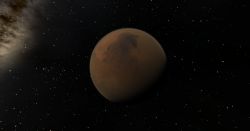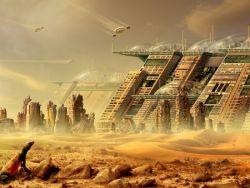Mars: различия между версиями
>Jackboot (lore-consistent reboot provided by Bokaza.) |
>Jackboot м (oops I pasted over too much stuff, readded) |
||
| Строка 12: | Строка 12: | ||
Mars is the fourth planet out from [[Sol]]. | Mars is the fourth planet out from [[Sol]]. | ||
== History == | |||
Due to the close proximity to Earth and despite its inhospitality, Mars has received a massive number of colonists during the first waves colonization. The byproduct of this is that many issues, national and cultural, that plagued humanity at that times, were brought over to the Red Planet. The colonies, more often than not, supported by nations of earth as legal colonies, were putting constant pressure and producing tensions between each other. Wars between the colonies, although rare, were not unheard of. Many colony states of Mars, although now independant, still boast of their heritage and binds to this or that past or present nation on Earth. | Due to the close proximity to Earth and despite its inhospitality, Mars has received a massive number of colonists during the first waves colonization. The byproduct of this is that many issues, national and cultural, that plagued humanity at that times, were brought over to the Red Planet. The colonies, more often than not, supported by nations of earth as legal colonies, were putting constant pressure and producing tensions between each other. Wars between the colonies, although rare, were not unheard of. Many colony states of Mars, although now independant, still boast of their heritage and binds to this or that past or present nation on Earth. | ||
These tensions, over the centuries, produced cultures and traditions unseen on other planets, which were much less involved in Earth politics. Denizens of Mars, at least those who are in position to care about such things, speak of their roots with pride. Some of the many culture groups on Mars still keep old traditions that have long since died out on Earth. | These tensions, over the centuries, produced cultures and traditions unseen on other planets, which were much less involved in Earth politics. Denizens of Mars, at least those who are in position to care about such things, speak of their roots with pride. Some of the many culture groups on Mars still keep old traditions that have long since died out on Earth. | ||
== The First Colonists == | ==The First Colonists== | ||
Due to the planet's low gravity, first colonists were handpicked among those who had the strongest bone density and later, cheap stable gene mods were introduced as part of the general medicine, to increase the survival rate. As technology developed, artificial gravity generators were introduced under the cities to rectify the health issues of being born in such an environment. This has, over many generations, made the average martian have an increased bone density and height. | Due to the planet's low gravity, first colonists were handpicked among those who had the strongest bone density and later, cheap stable gene mods were introduced as part of the general medicine, to increase the survival rate. As technology developed, artificial gravity generators were introduced under the cities to rectify the health issues of being born in such an environment. This has, over many generations, made the average martian have an increased bone density and height. | ||
| Строка 22: | Строка 23: | ||
Although a catastrophe, the terraforming project of Mars was not a complete failure. The air is still toxic, it effectively raised Mars' near zero pressure to tolerable 0.5 range, along with the average temperature. The air is still toxic. This difference meant that a space suit was no longer needed to traverse its surface, instead, pressure suits or thick clothing, along with eye, mouth and ear protection were enough to stop the worst effects of low pressure environment. The average Martian citizen, however, doesn't leave the martian mega arcologies more than a few times in their lives, but still, low pressure survival and suit usage is a mandatory part of education. The martian cities themselves are a maze of interconnected buildings, roadways and tunnels that most people have little grasp of and can hardly be navigated without a help of computers. With low police coverage and ease of its evasion, many criminal organizations have sprung up and remained for centuries, because of this, Mars boasts one of the largest and most enigmatic criminal underworlds in Sol space. | Although a catastrophe, the terraforming project of Mars was not a complete failure. The air is still toxic, it effectively raised Mars' near zero pressure to tolerable 0.5 range, along with the average temperature. The air is still toxic. This difference meant that a space suit was no longer needed to traverse its surface, instead, pressure suits or thick clothing, along with eye, mouth and ear protection were enough to stop the worst effects of low pressure environment. The average Martian citizen, however, doesn't leave the martian mega arcologies more than a few times in their lives, but still, low pressure survival and suit usage is a mandatory part of education. The martian cities themselves are a maze of interconnected buildings, roadways and tunnels that most people have little grasp of and can hardly be navigated without a help of computers. With low police coverage and ease of its evasion, many criminal organizations have sprung up and remained for centuries, because of this, Mars boasts one of the largest and most enigmatic criminal underworlds in Sol space. | ||
== Economy== | |||
Mars' economy is developed and mixed, with it's largest industries being orbital construction, mining, salvaging and a small but rapidly growing hydroponics industry. Mars also enjoys being the center of Sol trade, with over 90% of Sol's trade at some point passing through the planet or one of it's stations, due in no small part to the Bluespace Gate near the planet. | |||
== Politics == | |||
The planetary capital of Mars is Olympia, located within the Galle Crater Terraformed Zone, but a majority of senior administration facilities and personnel reside in orbit on New Concordia station along with the highest echelons of Sol Alliance leadership and bureaucracy. | |||
Версия от 09:35, 31 июля 2015


Star System: Sol
Capitals: Olympia (planetside); Nova Concordia Station (orbital)
Terrestrial Population (est.): 4,592,943,380
Spacer Population (est.): 1,372,248
Mars is the fourth planet out from Sol.
History
Due to the close proximity to Earth and despite its inhospitality, Mars has received a massive number of colonists during the first waves colonization. The byproduct of this is that many issues, national and cultural, that plagued humanity at that times, were brought over to the Red Planet. The colonies, more often than not, supported by nations of earth as legal colonies, were putting constant pressure and producing tensions between each other. Wars between the colonies, although rare, were not unheard of. Many colony states of Mars, although now independant, still boast of their heritage and binds to this or that past or present nation on Earth.
These tensions, over the centuries, produced cultures and traditions unseen on other planets, which were much less involved in Earth politics. Denizens of Mars, at least those who are in position to care about such things, speak of their roots with pride. Some of the many culture groups on Mars still keep old traditions that have long since died out on Earth.
The First Colonists
Due to the planet's low gravity, first colonists were handpicked among those who had the strongest bone density and later, cheap stable gene mods were introduced as part of the general medicine, to increase the survival rate. As technology developed, artificial gravity generators were introduced under the cities to rectify the health issues of being born in such an environment. This has, over many generations, made the average martian have an increased bone density and height.
Terraforming
Although a catastrophe, the terraforming project of Mars was not a complete failure. The air is still toxic, it effectively raised Mars' near zero pressure to tolerable 0.5 range, along with the average temperature. The air is still toxic. This difference meant that a space suit was no longer needed to traverse its surface, instead, pressure suits or thick clothing, along with eye, mouth and ear protection were enough to stop the worst effects of low pressure environment. The average Martian citizen, however, doesn't leave the martian mega arcologies more than a few times in their lives, but still, low pressure survival and suit usage is a mandatory part of education. The martian cities themselves are a maze of interconnected buildings, roadways and tunnels that most people have little grasp of and can hardly be navigated without a help of computers. With low police coverage and ease of its evasion, many criminal organizations have sprung up and remained for centuries, because of this, Mars boasts one of the largest and most enigmatic criminal underworlds in Sol space.
Economy
Mars' economy is developed and mixed, with it's largest industries being orbital construction, mining, salvaging and a small but rapidly growing hydroponics industry. Mars also enjoys being the center of Sol trade, with over 90% of Sol's trade at some point passing through the planet or one of it's stations, due in no small part to the Bluespace Gate near the planet.
Politics
The planetary capital of Mars is Olympia, located within the Galle Crater Terraformed Zone, but a majority of senior administration facilities and personnel reside in orbit on New Concordia station along with the highest echelons of Sol Alliance leadership and bureaucracy.